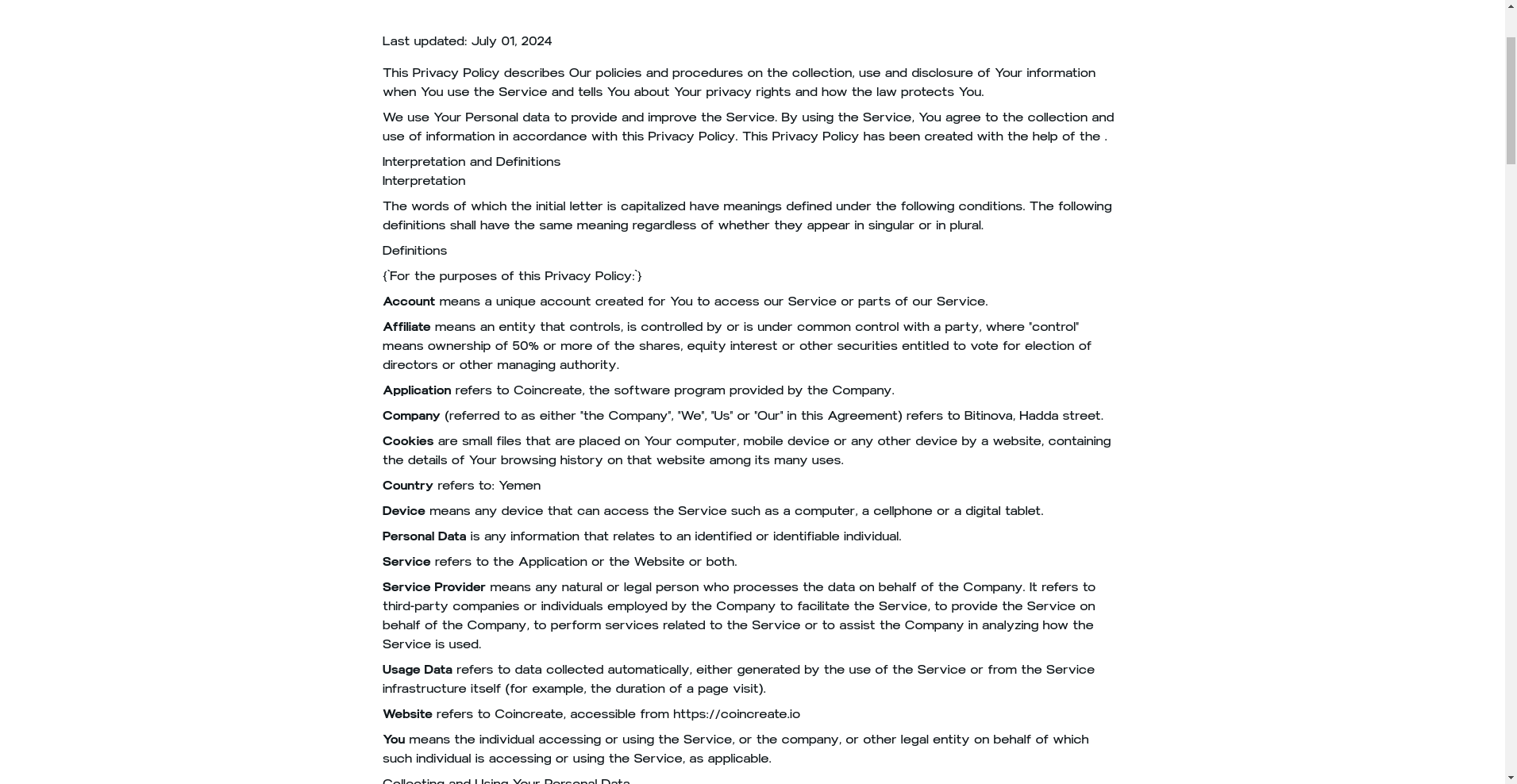Coincreate ($CC) Review: A Data-Driven Legitimacy and Risk Assessment

Project Overview
Coincreate is positioned as a no-code platform designed to democratize blockchain development. Its primary goal is to enable users of varying technical backgrounds to create and manage blockchain assets, such as tokens, NFTs, staking, vesting, governance, and other smart contracts, across multiple networks. The platform emphasizes ease of use, cost-efficiency, and broad accessibility, aiming to simplify what has traditionally been a complex and developer-centric process.
The platform’s technology leverages established security frameworks like OpenZeppelin smart contracts and supports multi-chain deployment, including Ethereum, Arbitrum, and Optimism. According to its publicly available data, Coincreate has a community of approximately 1,600 Discord members, a Twitter following nearing 6,000, and a market cap around $700,000, reflecting modest but active engagement. This article offers an impartial analysis, examining the project's credibility, security posture, economic model, and potential risks.
The Team and Roadmap Evaluation
The available information does not specify the identities or backgrounds of the core team members, which raises questions about transparency and credibility. The absence of well-known founders or verified industry figures could impact investor confidence, especially in a sector where trust and security are paramount.
Coincreate’s roadmap indicates ambitious milestones spread over 2024-2025, including:
- Q4 2024: Beta launch of core features (token, NFT, staking, ERC404 contracts), multi-chain integrations, and marketing campaigns.
- Q1-Q2 2025: Governance platform release with mobile app support.
- Q2 2025: Introduction of Real-World Asset (RWA) contracts for tokenizing physical assets.
- 2025 and beyond: Blockchain-as-a-Service (BaaS) offerings for custom blockchain deployment.
While the roadmap features logical development phases aligned with industry standards, the lack of detailed technical or team credentials tempers expectations regarding timely delivery and execution capacity. To assess their ability to meet these goals, one would need more transparent disclosures about team expertise, funding sources, and internal milestones. Understanding the importance of active development is crucial here.
Assessing the Security and Integrity of Coincreate
The security analysis relies solely on a single audit report from Cyberscope, which evaluated the project’s token smart contracts. The audit indicates a high security score of approximately 95.86% and a percentile ranking near the 99.5th percentile, suggesting rigorous review and low vulnerability levels in the audited contracts.
Key technical points include:
- High Cruciality Findings: The audit identified critical issues that were marked as resolved or addressed during iterations, though some high-criticality vulnerabilities may still exist temporarily until fully remediated. Understanding Cyberscope audit scores is important for context.
- Code Review and Best Practices: Utilization of OpenZeppelin libraries indicates adherence to industry standards, reducing common exploits like reentrancy or overflow vulnerabilities.
- Scope Limitations: The audit covers only token-related contracts. There is no publicly available security review of other core components, such as platform backend, cross-chain bridges, or user interface, which are equally critical for operational security. The limited scope of audits is a common concern, especially when comparing to the impact of bug bounty programs on crypto security.
Given only this partial audit, the security posture appears solid in terms of smart contract resilience. However, the absence of a comprehensive, externally verified security review encompassing the entire platform presents potential risks—particularly in areas involving user data, cross-chain interoperability, and multisignature or oracle integrations. Investors should consider that security remains a multi-layered concern; an audit score for contracts is positive but not conclusive of overall platform safety.
The lack of transparency around team credentials can be a significant red flag similar to those seen in identifying rug pulls in cryptocurrency, and the absence of detailed staking and vesting mechanisms information further compounds these concerns.
Tokenomics Breakdown
The project’s utility token, typically called $CC or similar, is central to its ecosystem. Based on available data, key aspects of its tokenomics include:
- Total Supply: Not explicitly disclosed; presumed to follow standard capped or inflationary models pending further disclosures.
- Initial Allocation: No detailed token distribution or vesting schedules are publicly available, raising questions about the distribution fairness and long-term incentive alignment.
- Use Cases: Token likely fuels transaction fees, governance participation, staking rewards, and platform incentives, but specific utility token use cases are sparse.
- Vesting & Incentives: No clear information on vesting schedules for team, advisors, or early investors, which is critical to assess potential dumping or price volatility risks.
- Economic Model Risks: Without comprehensive data, there’s concern about token inflation, potential centralization of token holdings, and long-term sustainability of rewards or fees.
Occasional updates seem to indicate a moderate market cap (~$700,000), which suggests modest liquidity and trading volume (~$4,200). The lack of detailed tokenomics documentation can hinder investor confidence, as economic sustainability and fair distribution remain unverified. Projects with robust tokenomics, like SKALE ($SKL), often provide more clarity.
Evaluating Ecosystem and Development Activity
Development activity, as reflected on the platform, shows ongoing iterations and technical updates, with Cyberscope’s audit confirming stages of contract deployment and address improvements. Community engagement appears active, with approximately 1,600 Discord members, some social media following, and regular community score assessments hovering around 55/100. The general meme culture in crypto can sometimes inflate perceived community engagement, but here it seems more organic.
Real progress includes the planned launch of core platform modules, multi-chain integrations, and upcoming features like governance and RWA contracts. Nonetheless, much of the public progress remains at the roadmap or announcement stage, with limited evidence of completed deployments or user adoption metrics beyond initial community engagement. Investors should also be wary of early warning signs of crypto project collapse.
While active development is a positive sign, the platform’s true traction will depend on broader ecosystem adoption, real-world user deployment, and security audits beyond token contracts. Existing activity indicates commitment but not yet market-level traction or widespread usage.
Review of Terms and Conditions
The publicly available privacy policies and terms predominantly focus on general data collection, user rights, and platform security. No controversial or overly restrictive contractual clauses have been identified in the documentation that could pose risk to investors or users. It is important to consider the legal disclaimers in high-risk crypto projects.
However, the lack of detailed legal disclosures, licensing information, or explicit platform liability limitations warrants caution. Users should be aware that deploying contracts via Coincreate may involve legal considerations depending on jurisdiction, especially with emerging standards like ERC404 or RWA tokens.
Final Analysis and Risk/Reward Summary
Coincreate presents itself as a promising, accessible platform for blockchain project deployment, backed by industry-standard security audits on its token contracts. Its multi-chain approach and comprehensive feature wishlist demonstrate vision and ambition. However, several factors temper its overall legitimacy and investment viability.
Primary strengths include:
- Solid smart contract security score indicating low technical vulnerabilities for token deployment.
- Active development and community engagement suggest ongoing progress and user support.
- Strategic multi-chain compatibility expands potential use cases.
Potential risks encompass:
- Lack of publicly verified team credentials impacting credibility and trustworthiness, a key factor in assessing centralization risks.
- Insufficient transparency on tokenomics and distribution raising concerns over economic stability and attractiveness for investors. This is a contrast to projects with well-defined tokenomics like SKALE.
- Limited scope of security audits covering only specific contract types and not the entire platform infrastructure.
- Dependence on continuous updates and community support for future success, which could falter if development slows or user adoption stalls.
In summary, while Coincreate demonstrates technical diligence in its core token contracts and has a plausible roadmap, the absence of transparency regarding team, complete security audit scope, and detailed tokenomics introduces a significant layer of risk. Potential investors should weigh these factors carefully, understanding that the platform is in a relatively early stage, with future success contingent upon execution, community trust, and broader ecosystem adoption. As always, rigorous due diligence and cautious allocation are recommended, especially when considering platforms that offer advanced features like tokenizing Real-World Assets.

Olivia Lewis
Sociotechnical Systems Analyst
I analyze the intersection of social networks and blockchain systems. I use data to expose how scammers manipulate communities with bots, FUD, and engineered hype.
Similar Projects
-
ETFSwap
In-Depth Review of ETFSwap: Crypto Scam Checker & Project Scam Review
-
Refund Your SOL
Refund Your SOL Review: Is This a Legit or Scam Crypto Project? | Crypto Scam Checker
-
Kekius Maximus Ai
Kekius Maximus Ai Review: Scam Check & Legitimacy Analysis
-
Cryptex Finance
Cryptex Finance ($CTX) Review: An Expert Analysis of Risks & Potential
-
ShapeShift FOX Token
ShapeShift FOX Token Review: Legitimacy, Risks & Long-Term Potential